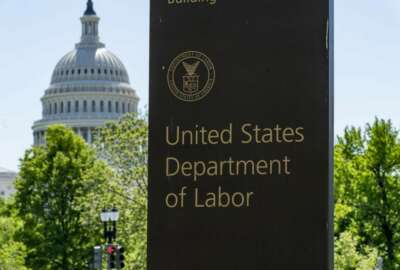

The Labor Department’s initiative to consolidate and centralize back-office functions would receive a boost in fiscal 2021 of at least $25 million for IT...
Best listening experience is on Chrome, Firefox or Safari. Subscribe to Federal Drive’s daily audio interviews on Apple Podcasts or PodcastOne.
House and Senate lawmakers in the fiscal 2021 spending bills are coming down hard on the governmentwide shared services effort to modernize payroll services.
Senate Appropriations Committee members would cut all funding for the NewPay initiative.
At same time, lawmakers from both houses of Congress are supporting the Labor Department’s internal shared services efforts. Legislators would give them more than $25 million in 2021 to further consolidate technology services through its working capital fund.
Maylin Jue, Labor’s enterprisewide shared services program manager, said money in the working capital fund is key for the agency to make more progress in 2021 and beyond under its back-office centralization and consolidation initiative.
“Next year we are rolling in all shared services into the working capital fund. This past year, we went with interagency agreements because that was the easiest thing in terms of lifting and shifting organizations from one place to another,” Jue said in an interview with Federal News Network. “With working capital funds, you can bring in all the money from the agencies and then you have one pot of money you are dealing with. It’s also no-year money so if there are savings from one year, you can apply them to the next year.”

The Senate Appropriations Committee, which released all of its spending bills on Nov. 10, wrote in the Labor bill that it would allocate $27.6 million for IT modernization efforts. In that is $4.9 million for support systems, and the rest is for infrastructure modernization efforts.
“The committee continues to request that the department submit a report to the Committees on Appropriations of the House of Representatives and the Senate not later than 90 days after enactment that provides an update on projects to be funded, planned activities and associated timelines, expected benefits and planned expenditures,” the bill states. “The report should also include completed activities, remaining activities and associated timelines, actual and remaining expenditures, explanation of any cost overruns and delays and corrective actions, as necessary, to keep the project on track and within budget.”
The House version, which passed in July, would give Labor $25.3 million for IT modernization.
“Information Technology (IT) Modernization provides a dedicated source of funding for departmentwide IT modernization projects together with funding through the department’s Working Capital Fund,” the House wrote.
Jue said some Labor components were submitting money into the working capital if they had been using the shared services for things like procurement or human resources. But if the component just started using the assorted services in 2020, then her office established interagency agreements to transfer funding.
“We have stood up a new centralized office of human resources. We transitioned all HR staff from across the department into one new office. This allows us to have more team building, training and customer outreach, and it allows us to optimize business processes,” Jue said. “We have seen improvement in the consistency of the services and making sure everyone is following the same policies across the department. We’ve gotten a lot of compliments from a lot of the agency about improvements in staffing, which is a huge win for the department to hire more effectively and efficiently.”
While the HR consolidation is furthest along, Labor’s end goal is to reduce costs and improve efficiencies and consistency across all administrative functions.
This is a similar goal of the governmentwide initiatives, such as NewPay.
But lawmakers have bigger concerns about the initiative led by the General Services Administration. GSA asked for $20 million in 2021.
“While GSA has been pre-designated by the Office of Management and Budget to serve as the quality service management office for civilian human resource management services, the committee understands that current GSA capacity is totally inadequate to help federal agencies move to more modern and cost efficient technologies for common mission support services such as payroll and other human resources services,” Senate lawmakers wrote. “As currently structured, the committee is also concerned that NewPay only addresses a very small percentage of the actual federal payroll services currently provided to federal employees by shared services providers. In addition, the committee is concerned about the lack of transparency and details thus far on any return on investment analysis regarding NewPay’s implementation cost impacts to current agency customers as well as the migration costs that federal agencies and departments might incur to transition current payroll and related systems to NewPay or other more modern systems.”
To address these challenges, the committee would want GSA to work with the largest federal civilian payroll and human resource management shared services provider for program management and implementation efforts associated with NewPay and related shared services initiatives.
“Given the lengthy process and timelines of GSA’s NewPay and Unified Shared Services Management initiatives, to improve the efficiency and effectiveness of current common mission shared services, and to avoid duplication of these efforts across other federal agencies and departments, the committee directs GSA to allow its shared services providers to actively market their current payroll, financial or other human resource management services to other federal agencies and departments,” the Senate committee wrote. “The committee recommendation does not include funding for GSA’s Working Capital Fund for migration and other costs associated with NewPay due to continued concerns regarding implementation costs and potential impact to current federal agency personnel and customers.”
The House version of the Financial Services and General Government spending bill doesn’t come down quite as hard, but still withholds funding and wants more transparency from GSA.
“GSA has also yet to provide detailed justifications, spend plans and obligations by category, activities, or services already funded with the $20,600,000 provided in fiscal 2019 for NewPay implementation by the Technology Modernization Fund,” the House committee wrote. “The committee understands that GSA has established a NewPay Project Management Office within its own organization. However, the committee wants to avoid establishing duplicative agency offices and expertise, and to ensure that millions of federal employees’ payroll and human resources services are not interrupted or adversely impacted during transition to NewPay’s limited services. The committee directs GSA to consult with the existing federal civilian payroll and human resource management shared services providers for the program management and implementation efforts associated with NewPay and related shared services initiatives, and to produce a report on those consultations with 180 days of enactment of this act.”
Concerns outlined by lawmakers are less present for agencies trying to consolidate internally first.
Now, as one source said, many of these Congressional concerns may be coming from members who represent Louisiana, where the Agriculture Department’s National Finance Center is located and provides hundreds of jobs to the community.
At the same time, however, agency-focused consolidation and centralization efforts rarely come up as hot button issues.
Labor’s Jue said the end goal of Labor’s efforts is the improved delivery of HR, IT, procurement and personnel security service
“Service will be more consistent across the department, as it will all fall under one service provider that utilizes standard policies and procedures,” she said. “Service will be compliant with federal regulations and will strive to meet industry best practices in both the public and private sectors. Creating centralized offices for administrative services will also allow more opportunities for innovation within the department. By improving IT functionality, providing more user friendly HR services, improving procurement efficiency and streamlining personnel security processing, DOL employees will be able to focus more on their mission rather than being burdened by administrative tasks.”
Jue said Labor saw the benefits of the consolidation efforts during the pandemic. She said employees switched over to telework without a problem because policies and processes were in place.
“My background is around performance management budget and process improvement so that is what we will be focusing on,” Jue said. “We will make sure we have the right metrics in place, and putting in place new metrics as needed. Then, we really are trying to optimize services by improving the processes, which over time that should lead us to cost savings.”
Copyright © 2025 Federal News Network. All rights reserved. This website is not intended for users located within the European Economic Area.
Jason Miller is executive editor of Federal News Network and directs news coverage on the people, policy and programs of the federal government.
Follow @jmillerWFED



